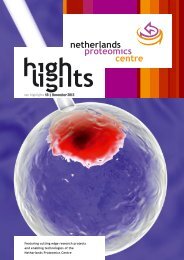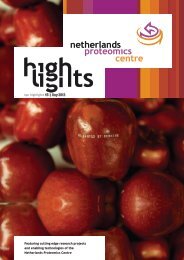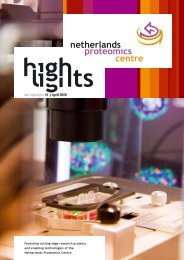NPC Valorisation Voucher - Netherlands Proteomics Centre
NPC Valorisation Voucher - Netherlands Proteomics Centre
NPC Valorisation Voucher - Netherlands Proteomics Centre
You also want an ePaper? Increase the reach of your titles
YUMPU automatically turns print PDFs into web optimized ePapers that Google loves.
anti-microbial effects [3, 4], whereas others can be classifiedamong protease inhibitors [4].General conclusion A common tool used to represent LC-MSdata as two-dimensional maps can be employed to reveal definedstructural features of the MS detected biochemical. Twodimensional(differential) peptide displays are elegant meansfor mining complex natural sources of potentially bioactivepeptides. They help focus on distinctive structural features ofthe peptides, thereby becoming part of the discovery strategyof peptides with bioactivity potential.As such this post-translational modification driven analyticalmethod embodies a complementary ‘reverse’ approach to thebioactivity based discovery of bioactive peptides. One startsby targeting potentially interesting peptides from a natural(microbial or vertebrate) source prior to elucidating their primarystructure, and finally analysing their biological activity/pharmacology. We have successfully utilised this strategy todiscover novel cysteine-containing peptides in various amphibianskin secretions. This led directly to the elucidation of thefull primary structure of several novel peptide bio-moleculesthat fit into different peptide families [3, 4]. It should be clearthat the approach is equally valid for peptide samples of anybiological origin.Being very generic, the method can be expanded — mutatismutandi — to look for analytes carrying many more PTMs, andwe, therefore designated the technique as PTM driven differentialpeptide display [3]. This is just limited by the creativityof the peptide chemist designing the specific chemical treatmentto be performed on the sample between the two LC-MSruns that will be compared.References1 Kastin, A.J. (2006) Handbook of Biologically ActivePeptides; Academic Press, 1640 pp.2 Verhaert, P. et al. (2009) Amphibian skin as a unique modelfor peptide analysis; <strong>NPC</strong> Highlights 9, 12-15.3 Evaristo, G.P.C. et al. (2012) PTM-driven DifferentialPeptide Display: Survey of Peptides Containing Inter/IntramolecularDisulfide Bridges in Frog Venoms, J. <strong>Proteomics</strong>:http://dx.doi.org/10.1016/j.prot.2012.09.0014 Evaristo, G. et al. (2012) The chains of the heterodimericamphibian skin antimicrobial peptide, distinctin, areencoded by separate messenger RNAs, J. <strong>Proteomics</strong>:http://dx.doi.org/10.1016/j.prot.2012.09.16Research teamFrom left to right:Geisa Evaristo, Peter Verhaert, Martijn Pinkse andMervin Pieterse, Department of Biotechnology, Facultyof Applied Sciences, Delft University of Technology.| 11ContactProf. Peter VerhaertAnalytical Biotechnology GroupDepartment of BiotechnologyDelft University of TechnologyJulianalaan 672628 BC Delft, the <strong>Netherlands</strong>T +31 15 278 2332p.d.e.m.verhaert@tudelft.nlsummaryWe use liquid chromatography – tandem mass spectrometry(LC-MS/MS) to identify peptides with potential bioactivity incomplex mixtures of native peptides from natural sources. Asde novo sequencing of non-tryptic peptides is still a very laboriousand time-consuming task, it makes sense to recognisethe most promising peptides from the mixture first, to avoidspending unnecessary efforts in the energy demanding structuralanalysis of uninteresting sample components.The concept is that via a two-dimensional display of a (set of)LC-MS/MS run(s) various interesting features of the peptide sampleinvestigated are elegantly visualised. Against the backgroundof the sample’s complexity, a select set of typical structural characteristicsindicative for biological activity are highlighted. Someof these can already be seen directly from the straightforwardtwo-dimensional plot of LC-MS/MS retention time versus massto-chargeratio. Others reveal themselves only after selectivechemical treatment of the peptide sample, i.e. in a differentialtwo-dimensional display of the LC-MS/MS data of the treated anduntreated sample. Employing this strategy, we efficiently localisespecific post-translational modifications typical for various classesof bioactive peptides found in nature. Examples include thetargeting of carboxyterminally amidated peptides, and (singly ormultiply) disulfide bridge-linked peptides in the skin secretion offive different amphibians. This has already led to the discoveryand full primary structure elucidation of several novel peptidebiomolecules with interesting bioactivities.






